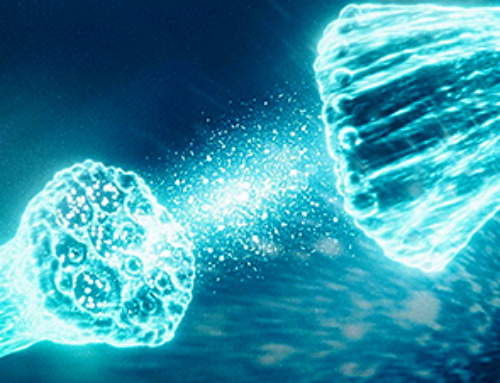A new study provides further evidence that consciousness depends on communication between the brain's sensory and cognitive regions in the cortex.
Our brains are constantly making predictions about our surroundings, enabling us to focus on and respond to unexpected events. A recent study explores how this predictive process functions during consciousness and how it changes under general anesthesia. The findings support the idea that conscious thought relies on synchronized communication between basic sensory areas and higher-order cognitive regions of the brain, facilitated by brain rhythms in specific frequency bands.
Previously, members of the research team at The Picower Institute for Learning and Memory at MIT and at Vanderbilt University had described how brain rhythms enable the brain to remain prepared to attend to surprises. Cognition-oriented brain regions (generally at the front of the brain), use relatively low-frequency alpha and beta rhythms to suppress processing by sensory regions (generally toward the back of the brain) of stimuli that have become familiar and mundane in the environment (e.g. your co-worker's music). When sensory regions detect a surprise (e.g. the office fire alarm), they use faster frequency gamma rhythms to tell the higher regions about it and the higher regions process that at gamma frequencies to decide what to do (e.g. exit the building).
Anesthesia's Impact on Brain Communication
The new results published Oct. 7 in the Proceedings of the National Academy of Sciences, show that when animals were under propofol-induced general anesthesia, a sensory region retained the capacity to detect simple surprises but communication with a higher cognitive region toward the front of the brain was lost, making that region unable to engage in its "top-down" regulation of the activity of the sensory region and keeping it oblivious to simple and more complex surprises alike.
"What we are doing here speaks to the nature of consciousness," said co-senior author Earl K. Miller, Picower Professor in The Picower Institute for Learning and Memory and MIT's Department of Brain and Cognitive Sciences. "Propofol general anesthesia deactivates the top-down processes that underlie cognition. It essentially disconnects communication between the front and back halves of the brain."

Co-senior author Andre Bastos, an assistant professor in the psychology department at Vanderbilt and a former member of Miller's MIT lab, added that the study results highlight the key role of frontal areas in consciousness.
"These results are particularly important given the newfound scientific interest in the mechanisms of consciousness, and how consciousness relates to the ability of the brain to form predictions," Bastos said.
The brain's ability to predict is dramatically altered during anesthesia. It was interesting that the front of the brain, areas associated with cognition, were more strongly diminished in their predictive abilities than sensory areas. This suggests that prefrontal areas help to spark an 'ignition' event that allows sensory information to become conscious. Sensory cortex activation by itself does not lead to conscious perception. These observations help us narrow down possible models for the mechanisms of consciousness."
Yihan Sophy Xiong, a graduate student in Bastos's lab who led the study. said the anesthetic reduces the times in which inter-regional communication within the
"In the awake brain, brain waves give short windows of opportunity for neurons to fire optimally – the 'refresh rate' of the brain, so to speak," Xiong said "This refresh rate helps organize different brain areas to communicate effectively. Anesthesia both slows down the refresh rate, which narrows these time windows for brain areas to talk to each other, and makes the refresh rate less effective, so that neurons become more disorganized about when they can fire. When the refresh rate no longer works as intended, our ability to make predictions is weakened."
Learning from oddballs
To conduct the research, the neuroscientists measured the electrical signals, "or spiking," of hundreds of individual neurons and the coordinated rhythms of their aggregated activity (at alpha/beta and gamma frequencies), in two areas on the surface, or cortex, of the brain of two animals as they listened to sequences of tones. Sometimes the sequences would all be the same note, (e.g. AAAAA). Sometimes there'd be a simple surprise that the researchers called a "local oddball" (e.g. AAAAB). But sometimes the surprise would be more complicated, or a "global oddball." For example, after seeing a series of AAAABs, there'd all of a sudden be AAAAA, which violates the global but not the local pattern.
Prior work has suggested that a sensory region (in this case the temporoparietal area, or Tpt) can spot local oddballs on its own, Miller said. Detecting the more complicated global oddball requires the participation of a higher-order region (in this case the Frontal Eye Fields, or FEF).
The animals heard the tone sequences both while awake and while under propofol anesthesia. There were no surprises about the waking state. The researchers reaffirmed that top-down alpha/beta rhythms from FEF carried predictions to the Tpt and that Tpt would increase gamma rhythms when an oddball came up, causing FEF (and the prefrontal cortex) to respond with upticks of gamma activity as well.
But by several measures and analyses, the scientists could see these dynamics break down after the animals lost consciousness.
Under propofol, for instance, spiking activity declined overall but when a local oddball came along, Tpt spiking still increased notably but now spiking in FEF didn't follow suit as it does during wakefulness.
Meanwhile, when a global oddball was presented during wakefulness, the researchers could use software to "decode" representation of that among neurons in FEF and the prefrontal cortex (another cognition-oriented region). They could also decode local oddballs in the Tpt. But under anesthesia the decoder could no longer reliably detect representation of local or global oddballs in FEF or the prefrontal cortex.
Moreover, when they compared rhythms in the regions amid wakeful vs. unconscious states they found stark differences. When the animals were awake, oddballs increased gamma activity in both Tpt and FEF and alpha/beta rhythms decreased. Regular, non-oddball stimulation increased alpha/beta rhythms. But when the animals lost consciousness the increase in gamma rhythms from a local oddball was even greater in Tpt than when the animal was awake.
"Under propofol-mediated loss of consciousness, the inhibitory function of alpha/beta became diminished and/or eliminated, leading to disinhibition of oddballs in sensory cortex," the authors wrote.
Other analyses of inter-region connectivity and synchrony revealed that the regions lost the ability to communicate during anesthesia.
In all, the study's evidence suggests that conscious thought requires coordination across the cortex, from front to back, the researchers wrote.
"Our results therefore suggest an important role for prefrontal cortex activation, in addition to sensory cortex activation, for conscious perception," the researchers wrote.
Reference: "Propofol-mediated loss of consciousness disrupts predictive routing and local field phase modulation of neural activity" by Yihan (Sophy) Xiong, Jacob A. Donoghue, Mikael Lundqvist, Meredith Mahnke, Alex James Major, Emery N. Brown, Earl K. Miller and André M. Bastos, 7 October 2024, Proceedings of the National Academy of Sciences.
DOI: 10.1073/pnas.2315160121
In addition to Xiong, Miller and Bastos, the paper's other authors are Jacob Donoghue, Mikael Lundqvist, Meredith Mahnke, Alex Major and Emery N. Brown.
The National Institutes of Health, The JPB Foundation, and The Picower Institute for Learning and Memory funded the study.
News
Scientists Unlock a New Way to Hear the Brain’s Hidden Language
Scientists can finally hear the brain’s quietest messages—unlocking the hidden code behind how neurons think, decide, and remember. Scientists have created a new protein that can capture the incoming chemical signals received by brain [...]
Does being infected or vaccinated first influence COVID-19 immunity?
A new study analyzing the immune response to COVID-19 in a Catalan cohort of health workers sheds light on an important question: does it matter whether a person was first infected or first vaccinated? [...]
We May Never Know if AI Is Conscious, Says Cambridge Philosopher
As claims about conscious AI grow louder, a Cambridge philosopher argues that we lack the evidence to know whether machines can truly be conscious, let alone morally significant. A philosopher at the University of [...]
AI Helped Scientists Stop a Virus With One Tiny Change
Using AI, researchers identified one tiny molecular interaction that viruses need to infect cells. Disrupting it stopped the virus before infection could begin. Washington State University scientists have uncovered a method to interfere with a key [...]
Deadly Hospital Fungus May Finally Have a Weakness
A deadly, drug-resistant hospital fungus may finally have a weakness—and scientists think they’ve found it. Researchers have identified a genetic process that could open the door to new treatments for a dangerous fungal infection [...]
Fever-Proof Bird Flu Variant Could Fuel the Next Pandemic
Bird flu viruses present a significant risk to humans because they can continue replicating at temperatures higher than a typical fever. Fever is one of the body’s main tools for slowing or stopping viral [...]
What could the future of nanoscience look like?
Society has a lot to thank for nanoscience. From improved health monitoring to reducing the size of electronics, scientists’ ability to delve deeper and better understand chemistry at the nanoscale has opened up numerous [...]
Scientists Melt Cancer’s Hidden “Power Hubs” and Stop Tumor Growth
Researchers discovered that in a rare kidney cancer, RNA builds droplet-like hubs that act as growth control centers inside tumor cells. By engineering a molecular switch to dissolve these hubs, they were able to halt cancer [...]
Platelet-inspired nanoparticles could improve treatment of inflammatory diseases
Scientists have developed platelet-inspired nanoparticles that deliver anti-inflammatory drugs directly to brain-computer interface implants, doubling their effectiveness. Scientists have found a way to improve the performance of brain-computer interface (BCI) electrodes by delivering anti-inflammatory drugs directly [...]
After 150 years, a new chapter in cancer therapy is finally beginning
For decades, researchers have been looking for ways to destroy cancer cells in a targeted manner without further weakening the body. But for many patients whose immune system is severely impaired by chemotherapy or radiation, [...]
Older chemical libraries show promise for fighting resistant strains of COVID-19 virus
SARS‑CoV‑2, the virus that causes COVID-19, continues to mutate, with some newer strains becoming less responsive to current antiviral treatments like Paxlovid. Now, University of California San Diego scientists and an international team of [...]
Lower doses of immunotherapy for skin cancer give better results, study suggests
According to a new study, lower doses of approved immunotherapy for malignant melanoma can give better results against tumors, while reducing side effects. This is reported by researchers at Karolinska Institutet in the Journal of the National [...]
Researchers highlight five pathways through which microplastics can harm the brain
Microplastics could be fueling neurodegenerative diseases like Alzheimer's and Parkinson's, with a new study highlighting five ways microplastics can trigger inflammation and damage in the brain. More than 57 million people live with dementia, [...]
Tiny Metal Nanodots Obliterate Cancer Cells While Largely Sparing Healthy Tissue
Scientists have developed tiny metal-oxide particles that push cancer cells past their stress limits while sparing healthy tissue. An international team led by RMIT University has developed tiny particles called nanodots, crafted from a metallic compound, [...]
Gold Nanoclusters Could Supercharge Quantum Computers
Researchers found that gold “super atoms” can behave like the atoms in top-tier quantum systems—only far easier to scale. These tiny clusters can be customized at the molecular level, offering a powerful, tunable foundation [...]
A single shot of HPV vaccine may be enough to fight cervical cancer, study finds
WASHINGTON -- A single HPV vaccination appears just as effective as two doses at preventing the viral infection that causes cervical cancer, researchers reported Wednesday. HPV, or human papillomavirus, is very common and spread [...]





















